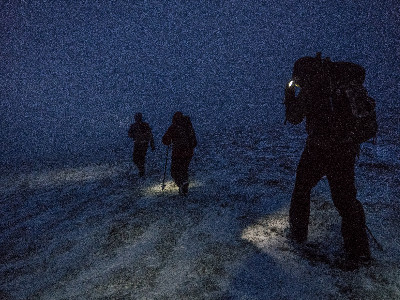By Sandy Paterson

We can all imagine it I am sure, that worst case scenario: you are immobile (badly twisted ankle, broken leg or whatever) and you have no phone signal. Now you could be sitting there thinking it is OK because your wife/husband/friend will realise soon that you are not back home soon and raise the alarm because they know what your plans are and when you would aim to be home. Or you might be sitting there thinking: “If only…” If only you had left them some info about where you were going and when they should expect you back.
Having a ‘late back’ procedure in my mind is vital, no matter if I am out playing or with clients, and it can be simple to do and cause no extra hassle to the day’s prep. In its simplest form it is basically the information of where you have gone for the day, when you hope to be back and when to worry and what to do if you have not heard from me.
You can leave this information however you want: in written form, photos of guide books etc. My preference is to either draw on a laminated map or, more often now, annotate my Viewranger map on my phone and send a screenshot to my late back contact. See the basic example pictured.

You can leave this information however you want: in written form, photos of guide books etc. My preference is to either draw on a laminated map or, more often now, annotate my Viewranger map on my phone and send a screenshot to my late back contact. See the basic example pictured.
What is the plan for the day? Is it to practice navigation, climb a route etc? It is always useful for rescue teams to know what your aim for the day is; it will help them start to piece together were you might be and what might have gone wrong.
This is not a whole packing list, but what safety equipment you have
(group shelter, First Aid, blizzard bag) and also any other significant
equipment like tents etc.

This is the time that you want your contact to start trying to get hold of you, giving your mobile a call or anyone else who is with you. For me this is not a fixed time (for example 2 hours after my due back time) as the weather and my activity for the day will dictate the time. If it is good weather and I am out teaching navigation in a friendly area, if I am late it will probably be because I have done extra; if it is a wild winter day and I am climbing I would try not to be later than necessary and, if something has gone wrong, the sooner I get help the better.
It could be that the procedure is to go straight to phoning Police/Mountain Rescue. This is not my procedure: my wife is my late back person and I like to think she has an emotional connection with me! She is also not a mountain person, so her task if she needs to raise a concern is to phone one of a few people on a list who are all friends and mountain people who can make more informed decisions. It takes the stress of organising off her and hands it over to someone else, who can potentially think more logically and make a more informed decision.
As mentioned above the route and location is often drawn/annotated onto a map. However, the group names, kit and timings are on a laminated sheet of A4 that has certain info/questions permanently added and then blanks to be filled in each time I am out. See the example sheet shown.
The key thing here is that the info is left in a visible place, so the contact person does not forget about it! In our house the info goes on the fridge so it will be clearly visible whilst dinner is being prepared, the normal time for returning home.
The above is just one example of a late back procedure that works well for myself and my work and homelife. It may not work for you, but there will be some system that does work and I can’t stress enough the importance of having some sort of late back procedure in place. Hopefully you will never have to use it, but you will be so glad if it is one day needed.
Sandy Paterson is a Mountaineering Instructor based in Scotland working in both summer and winter running Scotch on the Rocks Guiding (www.sotrg.co.uk) who deliver the summer and winter Mountain Leader Training and Assessment. When not running his own company, he works as the Development Officer for AMI.
Association of Mountaineering Instructors
The Association of Mountaineering Instructors (AMI) is the representative body for professionally qualified Mountaineering Instructors in the UK and Ireland.
AMI members are highly experienced mountaineers who have undergone rigorous training and assessment to qualify under the Mountain Training UK (MTUK) Mountaineering Instructor scheme. AMI is committed to promoting good practice in all mountaineering instruction. By employing an AMI member you will be in the very best of hands. Look for the AMI logo as assurance of high quality instruction. www.ami.org.uk